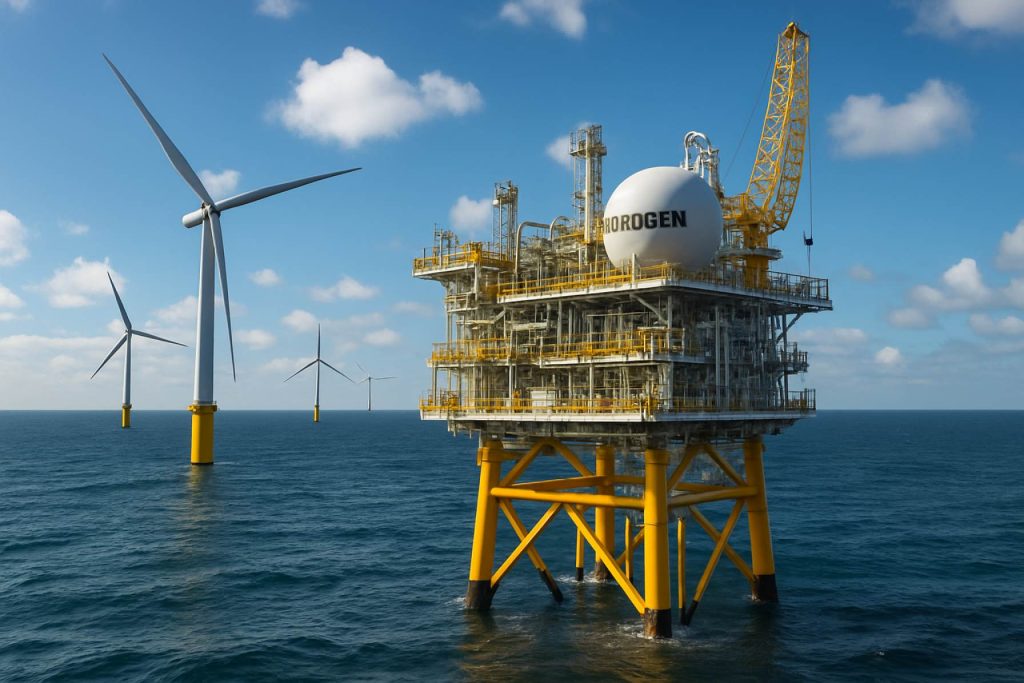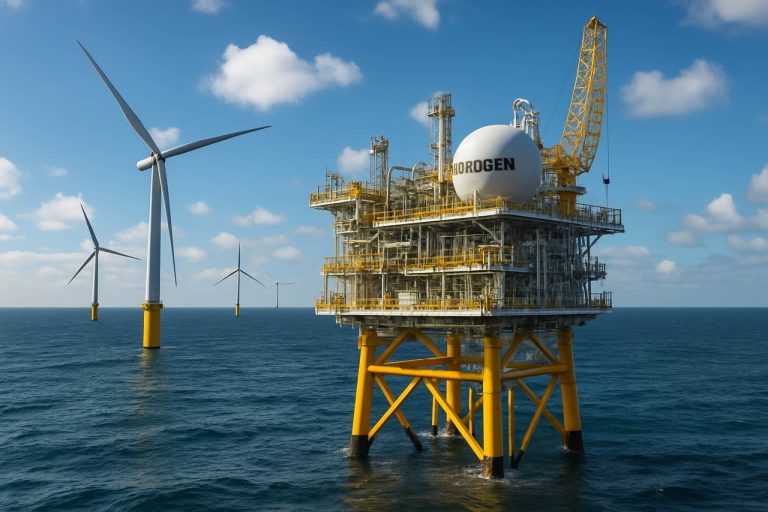
Unlocking the Power of Offshore Wind-to-Hydrogen Platforms: How Ocean-Based Innovation is Transforming the Future of Green Energy. Discover the Game-Changing Technologies Driving Sustainable Hydrogen Production Offshore.
- Introduction: The Rise of Offshore Wind-to-Hydrogen Platforms
- How Offshore Wind Powers Hydrogen Production
- Key Technologies and Engineering Challenges
- Economic Viability and Investment Trends
- Environmental Impact and Sustainability Benefits
- Global Projects and Case Studies
- Regulatory Landscape and Policy Support
- Future Outlook: Scaling Up and Integration with Energy Grids
- Conclusion: The Role of Offshore Wind-to-Hydrogen in the Energy Transition
- Sources & References
Introduction: The Rise of Offshore Wind-to-Hydrogen Platforms
Offshore wind-to-hydrogen platforms represent a transformative approach to renewable energy integration, combining the vast potential of offshore wind power with the flexibility and storage capabilities of green hydrogen production. These platforms utilize offshore wind turbines to generate electricity, which is then used to power electrolyzers that split water into hydrogen and oxygen. The resulting hydrogen can be transported to shore via pipelines or ships, providing a versatile energy carrier for sectors such as industry, transport, and heating.
The rise of offshore wind-to-hydrogen platforms is driven by several converging trends. First, the rapid expansion of offshore wind capacity, particularly in Europe and Asia, has created opportunities to harness surplus renewable electricity for hydrogen production. Second, the global push for decarbonization and energy security has accelerated investment in green hydrogen as a clean alternative to fossil fuels. Offshore platforms offer unique advantages, such as proximity to high-capacity wind resources, reduced grid congestion, and the ability to supply hydrogen directly to coastal industrial clusters.
Major pilot projects and policy initiatives are already underway. For example, the National Renewable Energy Laboratory in the United States and the North Sea Wind Power Hub consortium in Europe are exploring large-scale offshore hydrogen production. These efforts are supported by ambitious government targets and funding mechanisms, signaling a pivotal shift toward integrated offshore energy systems. As technology matures and costs decline, offshore wind-to-hydrogen platforms are poised to play a central role in the global energy transition.
How Offshore Wind Powers Hydrogen Production
Offshore wind-to-hydrogen platforms leverage the abundant and consistent wind resources found at sea to generate renewable electricity, which is then used to power electrolyzers that split water into hydrogen and oxygen. The process begins with offshore wind turbines converting kinetic wind energy into electrical energy. This electricity is either transmitted directly to shore or, increasingly, used on-site to produce green hydrogen via electrolysis. By situating electrolyzers on offshore platforms, the need for high-capacity electrical transmission infrastructure to shore can be reduced, as hydrogen can be transported via pipelines or ships, offering greater flexibility and potentially lower costs for long-distance energy transport.
The integration of wind power and hydrogen production offshore addresses several challenges associated with renewable energy. It enables the storage of excess wind energy in the form of hydrogen, mitigating the intermittency of wind power and providing a stable, dispatchable energy carrier. This synergy is particularly valuable for decarbonizing hard-to-electrify sectors such as heavy industry, shipping, and aviation. Furthermore, offshore wind-to-hydrogen platforms can be located far from densely populated coastal areas, minimizing land use conflicts and visual impacts.
Recent pilot projects, such as the Siemens Energy and Ørsted initiatives in the North Sea, demonstrate the technical feasibility and growing commercial interest in this approach. As electrolyzer technology advances and offshore wind costs continue to fall, the integration of these systems is expected to play a pivotal role in the global transition to a low-carbon hydrogen economy.
Key Technologies and Engineering Challenges
Offshore wind-to-hydrogen platforms represent a convergence of advanced renewable energy and electrochemical technologies, but their deployment faces significant engineering challenges. At the core, these platforms integrate offshore wind turbines with water electrolysis units, enabling the direct conversion of wind-generated electricity into hydrogen at sea. The most common electrolyzer technologies considered are Proton Exchange Membrane (PEM) and Alkaline Electrolyzers, each with distinct operational requirements and efficiencies. PEM electrolyzers, for instance, are favored for their rapid response to variable wind power, but they require rare and costly materials, while alkaline systems are more mature but less flexible in dynamic offshore conditions (International Energy Agency).
A major engineering challenge is the harsh marine environment, which accelerates corrosion and material degradation. Platform design must ensure structural integrity against extreme weather, saltwater exposure, and biofouling. Additionally, integrating large-scale hydrogen production equipment onto offshore platforms demands innovative solutions for space optimization, weight distribution, and safety systems to manage hydrogen’s flammability (DNV).
Another critical issue is the transport of hydrogen to shore. Options include subsea pipelines, which require robust materials and leak detection systems, or conversion of hydrogen to carriers like ammonia or liquid organic hydrogen for shipping. Each method introduces further technical and economic considerations. Finally, the intermittent nature of wind power necessitates advanced energy management systems and storage solutions to ensure stable hydrogen output and grid integration (Offshore WIND).
Economic Viability and Investment Trends
The economic viability of offshore wind-to-hydrogen platforms is rapidly evolving, driven by declining costs in both offshore wind generation and electrolyzer technologies. Recent analyses indicate that the levelized cost of hydrogen (LCOH) produced from offshore wind could become competitive with fossil-based hydrogen by the early 2030s, particularly in regions with high wind resources and supportive policy frameworks. Key cost drivers include capital expenditures for offshore wind farms, the integration of electrolyzers (either onshore or offshore), and the infrastructure required for hydrogen transport and storage. Innovations such as direct offshore hydrogen production and pipeline transport are being explored to further reduce costs and logistical complexities.
Investment trends reflect growing confidence in the sector. Major energy companies and consortia are announcing large-scale demonstration projects, such as the Shell Hydrogen Holland I and the Ørsted SeaH2Land initiatives, which aim to integrate gigawatt-scale offshore wind with hydrogen production. Public funding and policy incentives, particularly in the European Union and the United Kingdom, are catalyzing private investment and de-risking early-stage projects. The European Commission’s REPowerEU Plan and the UK’s Hydrogen Strategy both set ambitious targets for green hydrogen production, further stimulating market growth.
Despite these positive trends, challenges remain, including regulatory uncertainty, the need for coordinated infrastructure development, and the high upfront capital requirements. However, as technology matures and economies of scale are realized, offshore wind-to-hydrogen platforms are poised to play a pivotal role in the global energy transition.
Environmental Impact and Sustainability Benefits
Offshore wind-to-hydrogen platforms offer significant environmental and sustainability benefits compared to conventional hydrogen production methods. Traditional hydrogen is predominantly produced via steam methane reforming, a process that emits substantial amounts of CO2 and relies on fossil fuels. In contrast, offshore wind-to-hydrogen systems utilize renewable wind energy to power electrolysis, splitting water into hydrogen and oxygen without direct greenhouse gas emissions. This approach enables the production of “green hydrogen,” which can play a crucial role in decarbonizing sectors such as heavy industry, shipping, and energy storage.
The offshore location of these platforms minimizes land use conflicts and visual impacts often associated with onshore renewable energy projects. Additionally, by colocating hydrogen production with wind farms, transmission losses are reduced, and the need for extensive undersea cabling to shore is minimized. This integration can also help balance grid fluctuations by diverting excess wind power to hydrogen production during periods of low electricity demand, thus enhancing overall system flexibility and resilience.
From a sustainability perspective, offshore wind-to-hydrogen platforms contribute to the reduction of air pollutants and support the transition to a circular, low-carbon economy. They also align with international climate goals, such as those outlined by the United Nations Framework Convention on Climate Change and the European Commission. However, careful consideration must be given to potential marine ecosystem impacts, including noise, habitat disruption, and water use, necessitating robust environmental assessments and adaptive management strategies.
Global Projects and Case Studies
The deployment of offshore wind-to-hydrogen platforms is gaining momentum worldwide, with several pioneering projects demonstrating the technical and economic feasibility of integrating green hydrogen production with offshore wind resources. In Europe, the Ørsted SeaH2Land project in the North Sea aims to connect gigawatt-scale offshore wind farms to electrolysis facilities, targeting industrial hydrogen supply for the Netherlands and Belgium. Similarly, the ENGIE and Equinor H2M project explores offshore hydrogen production and pipeline transport to shore, addressing grid congestion and storage challenges.
The Neptune Energy PosHYdon pilot in the Dutch North Sea is the world’s first offshore green hydrogen pilot, integrating a megawatt-scale electrolyzer on an operational gas platform. This project tests the full value chain, from wind-powered electrolysis to blending hydrogen with natural gas for transport to shore. In the UK, the Crown Estate is supporting feasibility studies for offshore hydrogen hubs, while in Germany, the North Sea Wind Power Hub consortium is evaluating large-scale offshore hydrogen production as part of a transnational energy island concept.
These projects highlight diverse approaches to platform design, grid integration, and hydrogen transport, reflecting regional energy strategies and regulatory frameworks. The lessons learned from these case studies are shaping best practices and informing the next generation of offshore wind-to-hydrogen developments globally.
Regulatory Landscape and Policy Support
The regulatory landscape for offshore wind-to-hydrogen platforms is rapidly evolving, shaped by the intersection of energy, maritime, and environmental policies. These platforms, which integrate offshore wind generation with electrolyzers to produce green hydrogen at sea, face a complex web of permitting, safety, and grid integration requirements. In the European Union, the European Commission has set ambitious targets for renewable hydrogen production, with the Hydrogen Strategy and the Offshore Renewable Energy Strategy providing frameworks for cross-border projects and funding mechanisms. National governments, such as the UK Government and Germany’s Federal Ministry for Economic Affairs and Climate Action, have introduced dedicated hydrogen roadmaps, including streamlined permitting for offshore infrastructure and financial incentives for pilot projects.
However, regulatory uncertainty remains a barrier. Key challenges include harmonizing maritime spatial planning, clarifying ownership and operational responsibilities for offshore hydrogen assets, and developing safety standards for offshore hydrogen production and transport. The lack of established certification schemes for green hydrogen and the need for coordinated grid and pipeline access further complicate project development. Policy support is increasingly focused on de-risking investments through grants, contracts for difference, and public-private partnerships, as seen in the International Energy Agency’s recommendations. As the sector matures, ongoing regulatory innovation and international cooperation will be critical to unlocking the full potential of offshore wind-to-hydrogen platforms.
Future Outlook: Scaling Up and Integration with Energy Grids
The future outlook for offshore wind-to-hydrogen platforms is marked by ambitious scaling-up efforts and deeper integration with national and regional energy grids. As governments and industry stakeholders intensify decarbonization targets, the deployment of large-scale offshore hydrogen production is expected to accelerate, leveraging the vast wind resources available at sea. Key to this expansion is the development of modular, scalable platform designs that can be replicated across multiple sites, reducing costs through standardization and economies of scale.
Integration with energy grids presents both opportunities and challenges. Offshore hydrogen platforms can act as flexible energy hubs, converting excess wind power into green hydrogen during periods of low electricity demand and feeding it into hydrogen pipelines or storage facilities. This not only helps balance grid fluctuations but also enables the export of renewable energy in the form of hydrogen to regions with limited renewable resources. However, technical hurdles remain, including the need for robust subsea infrastructure, efficient electrolyzer technologies, and harmonized regulatory frameworks to facilitate cross-border hydrogen trade.
Pilot projects in the North Sea and other regions are already demonstrating the feasibility of these concepts, with support from entities such as the International Energy Agency and the European Commission. Looking ahead, the successful scaling and integration of offshore wind-to-hydrogen platforms will depend on continued innovation, investment, and international collaboration to create a resilient, interconnected hydrogen economy.
Conclusion: The Role of Offshore Wind-to-Hydrogen in the Energy Transition
Offshore wind-to-hydrogen platforms are poised to play a pivotal role in the global energy transition, offering a scalable and flexible pathway to decarbonize sectors that are otherwise difficult to electrify. By directly coupling offshore wind generation with electrolysis, these platforms enable the production of green hydrogen at source, minimizing transmission losses and leveraging abundant wind resources far from shore. This approach not only supports the integration of variable renewable energy into the energy system but also provides a means to store and transport renewable energy in the form of hydrogen, addressing intermittency and grid congestion challenges.
The deployment of offshore wind-to-hydrogen platforms aligns with ambitious climate targets set by governments and international organizations, such as the European Union’s Green Deal and Hydrogen Strategy, which emphasize the need for large-scale renewable hydrogen production to achieve net-zero emissions by 2050 (European Commission). Furthermore, these platforms can stimulate new industrial value chains, create jobs, and foster innovation in both the offshore wind and hydrogen sectors.
However, realizing the full potential of offshore wind-to-hydrogen platforms requires overcoming technical, regulatory, and economic barriers. Continued investment in research, demonstration projects, and supportive policy frameworks will be essential to drive down costs and accelerate commercialization (International Energy Agency). As these challenges are addressed, offshore wind-to-hydrogen platforms are expected to become a cornerstone of a resilient, low-carbon energy system, supporting the transition to a sustainable future.
Sources & References
- National Renewable Energy Laboratory
- North Sea Wind Power Hub
- Siemens Energy
- International Energy Agency
- DNV
- Offshore WIND
- Shell Hydrogen Holland I
- REPowerEU Plan
- Hydrogen Strategy
- Equinor
- Hydrogen Strategy
- Offshore Renewable Energy Strategy
- Germany’s Federal Ministry for Economic Affairs and Climate Action



